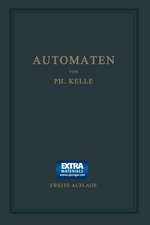Design for Creep
Autor R. K. Penny, D.L. Marriotten Limba Engleză Paperback – 5 oct 2012
| Toate formatele și edițiile | Preț | Express |
|---|---|---|
| Paperback (1) | 2097.08 lei 43-57 zile | |
| SPRINGER NETHERLANDS – 5 oct 2012 | 2097.08 lei 43-57 zile | |
| Hardback (1) | 2134.80 lei 43-57 zile | |
| SPRINGER NETHERLANDS – 31 iul 1995 | 2134.80 lei 43-57 zile |
Preț: 2097.08 lei
Preț vechi: 2557.42 lei
-18% Nou
Puncte Express: 3146
Preț estimativ în valută:
401.40€ • 436.16$ • 337.40£
401.40€ • 436.16$ • 337.40£
Carte tipărită la comandă
Livrare economică 21 aprilie-05 mai
Preluare comenzi: 021 569.72.76
Specificații
ISBN-13: 9789401042482
ISBN-10: 9401042489
Pagini: 444
Ilustrații: X, 430 p.
Dimensiuni: 155 x 235 x 23 mm
Greutate: 0.68 kg
Ediția:2nd ed. 1995. Softcover reprint of the original 2nd ed. 1995
Editura: SPRINGER NETHERLANDS
Colecția Springer
Locul publicării:Dordrecht, Netherlands
ISBN-10: 9401042489
Pagini: 444
Ilustrații: X, 430 p.
Dimensiuni: 155 x 235 x 23 mm
Greutate: 0.68 kg
Ediția:2nd ed. 1995. Softcover reprint of the original 2nd ed. 1995
Editura: SPRINGER NETHERLANDS
Colecția Springer
Locul publicării:Dordrecht, Netherlands
Public țintă
ResearchCuprins
1 Introduction.- 1.1 Definition of the problem.- 1.2 Information available.- 1.3 The use of data in component analysis and life assessment.- 1.4 Some basic definitions of terms used.- References.- 2 Factors affecting strain accumulation.- 2.1 Creep under constant uniaxial stress.- 2.2 Creep under variable uniaxial stress.- 2.3 A comparison of uniaxial creep theories.- 2.4 Conclusions regarding uniaxial creep theories.- 2.5 Effects of multiaxial stress.- References.- 3 Methods of analysis for constant loading and temperature conditions.- 3.1 Basics of stress/strain analysis.- 3.2 Calculation of stress redistribution.- 3.3 Methods of analysis which include damage effects.- 3.4 Observations of general interest.- 3.5 Other remarks.- References.- 4 Solutions to problems encountered in practice.- 4.1 ‘Exact’computation for variable loading.- 4.2 Approximate calculation.- 4.3 Reference Stress Methods.- 4.4 Creep buckling.- 4.5 Experiment as a design tool.- References.- 5 Continuum damage.- 5.1 Review of differet types of continuum creep damage.- 5.2 Modelling of damage processes and reduction to design essentials.- 5.3 Effects of stress states.- 5.4 Component response to continuum damage.- References.- 6 Extrapolation of creep strain and rupture data.- 6.1 Developments of extrapolation techniques.- 6.2 Methods of extrapolation of rupture data.- 6.3 Extrapolation of other creep quantities.- 6.4 Discussion of extrapolation methods.- 6.5 Conclusions.- References.- 7 Creep fracture.- 7.1 Fundamentals of fracture mechanics.- 7.2 Linear elastic fracture mechanics.- 7.3 Inelastic time-independent fracture.- 7.4 Creep crack growth.- 7.5 Transient creep cracking.- 7.6 How critical is creep cracking? Putting some numbers to it.- 7.7 Conclusion.- References.- 8Creep/fatigue/environmental interactions.- 8.1 Isothermal creep/fatigue interaction.- 8.2 A comparison of creep/fatigue assessment methods.- 8.3 Environment/creep/fatigue interaction.- 8.4 Thermal and thermomechanical fatigue.- 8.5 Conclusion.- References.- 9 High-temperature design procedures.- 9.1 Low-temperature design methods.- 9.2 Design for high temperature.- 9.3 Presentation of creep material data — the isochronous curve.- 9.4 Future developments.- References.- Appendix 1 The mechanics of tensile testing.- Appendix 2 Definition of terms involved in thin plate and thick shell problems.- Appendix 3 Optimum determination of material constants.- Appendix 4 Sample calculations.- Appendix 5 Finite element methods of structural analysis.- Appendix 6 Developments of the Kachanov damage concepts.- Appendix 7 Approximate solutions in linear elastic fracture mechanics.
Recenzii
This is an excellent textbook on engineering aspects of creep and is highly recommended for anyone interested in the design and analysis of components operating in the creep range. - Journal of Strain Analysis
















